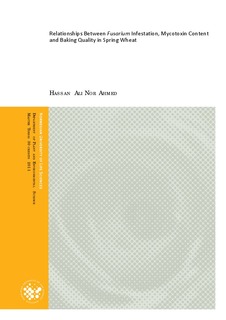| dc.description.abstract | Fusariums infestation in spring wheat (Triticum aestivum) has become more severe in Norway and it is often questioned if this also can affect the baking quality. In this study, two different materials were selected to investigate this hypothesis. One
material consisted of wheat samples harvested at different developmental stages during grain filling, and both grain quality development and Fusarium infestation of different Fusarium species were followed. The second materials were consisted of wheat samples harvested at different years to investigate how different levels of mycotoxin content in grains influence baking quality. This thesis performed and studied the modifications and quality changes during kernel development. Another distinctive aspect of this investigation was the detection of the
Fusarium species infested at particular developmental stage in spring wheat and their infestation levels (%). In addition, mycotoxin content in grains and the its influence in baking quality were tested. A part of the plant material (material 1) been used in the investigation were collected in Vollebekk experimental farm in 2009, Ås, Norway. Materials were harvested from 10 days after anthesis (DAA). Harvestings were done at each 5 DAA until 40 DAA. The second part of the material was collected from Roverud, Norway in the years 2006, 2007 and 2008. Both grain size and grain quality tend to develop normally. Infestation levels of different species revealed that F. avenaceum was extraordinarily highly dominant F. species obtained in this data. It was more than 50% at 20 DAA, and more than 70% at 40 DAA. The Fusarium species identified in this research presented the following order of prevalence; F. avenaceum, F. culmorum, F. graminearum, F. equiseti. On the other hand, the potential relationship between mycotoxin content in the grains and baking quality parameters being tested in material 2 revealed that, there was no significant correlations been observed in general. However, slightly positive relation between protein content (%) compared to grain mycotoxin content couldn’t expose any at least in this data.
Mycotoxins estimated means between the years 2006, 2007 and 2008 revealed
insignificant in Roverud, even though the estimated means deviated as much as more than two folds greater mycotoxin in 2006 than in 2008. | no_NO |
